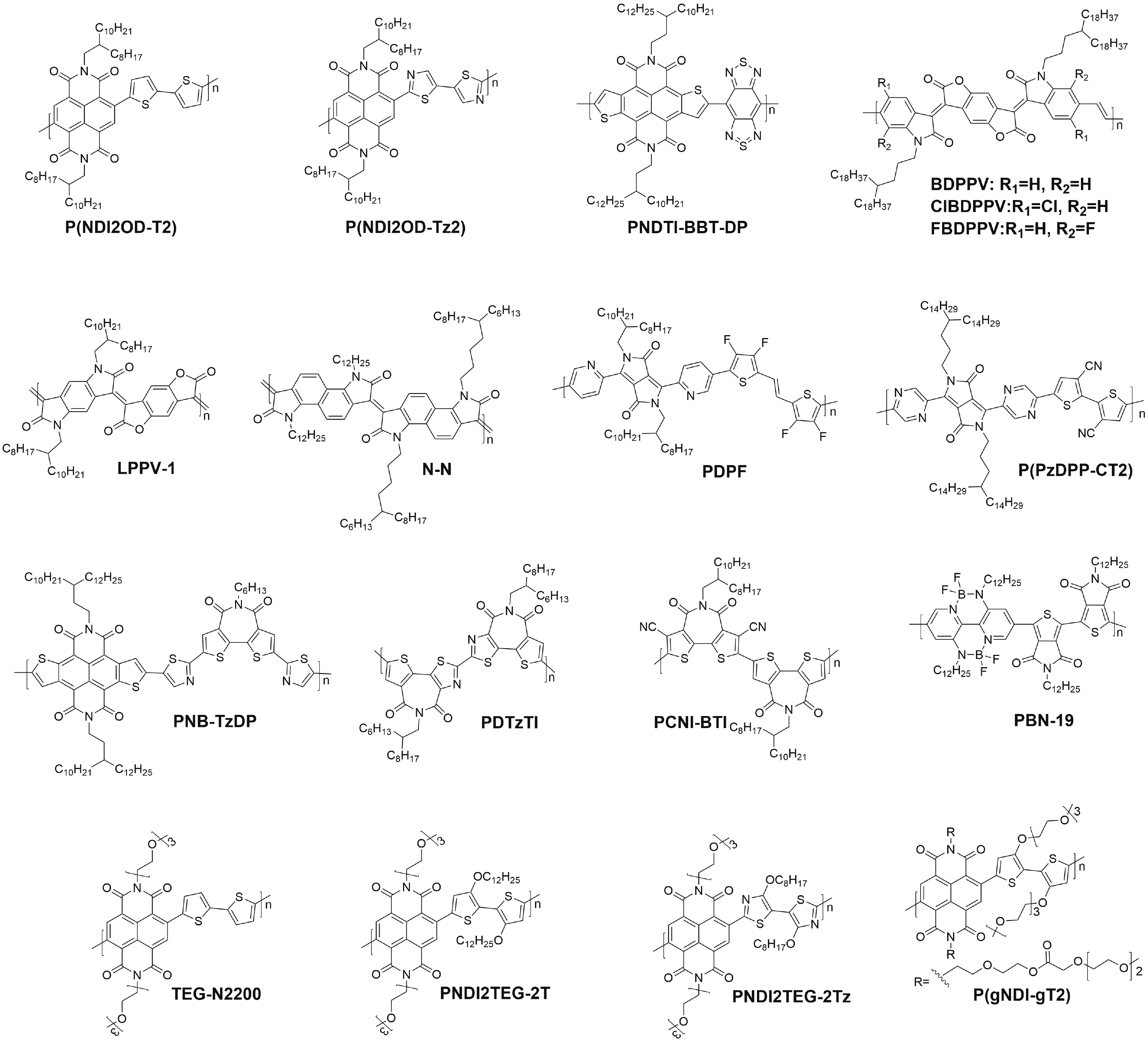| Citation: |
Xin Wang, Yongqiang Shi, Liming Ding. To enhance the performance of n-type organic thermoelectric materials[J]. Journal of Semiconductors, 2022, 43(2): 020202. doi: 10.1088/1674-4926/43/2/020202
****
X Wang, Y Q Shi, L M Ding, To enhance the performance of n-type organic thermoelectric materials[J]. J. Semicond., 2022, 43(2): 020202. doi: 10.1088/1674-4926/43/2/020202.
|
To enhance the performance of n-type organic thermoelectric materials
DOI: 10.1088/1674-4926/43/2/020202
More Information
-
References
[1] Guo X, Facchetti A. The journey of conducting polymers from discovery to application. Nat Mater, 2020, 19, 922 doi: 10.1038/s41563-020-0778-5[2] Kiefer D, Kroon R, Hofmann A I, et al. Double doping of conjugated polymers with monomer molecular dopants. Nat Mater, 2019, 18, 149 doi: 10.1038/s41563-018-0263-6[3] Lu Y, Wang J, Pei J. Strategies to enhance the conductivity of n-type polymer thermoelectric materials. Chem Mater, 2019, 31, 6412 doi: 10.1021/acs.chemmater.9b01422[4] Zhang F, Di C. Exploring thermoelectric materials from high mobility organic semiconductors. Chem Mater, 2020, 32, 2688 doi: 10.1021/acs.chemmater.0c00229[5] Jin K, Hao F, Ding L. Solution-processable n-type organic thermoelectric materials. Sci Bull, 2020, 65, 1862 doi: 10.1016/j.scib.2020.07.036[6] Xu K, Sun H, Ruoko T P, et al. Ground-state electron transfer in all-polymer donor–acceptor heterojunctions. Nat Mater, 2020, 19, 738 doi: 10.1038/s41563-020-0618-7[7] Wang S, Sun H, Ail U, et al. Thermoelectric properties of solution-processed n-doped ladder-type conducting polymers. Adv Mater, 2016, 28, 10764 doi: 10.1002/adma.201603731[8] Lu Y, Yu Z, Zhang R, et al. Rigid coplanar polymers for stable n-type polymer thermoelectrics. Angew Chem Int Ed, 2019, 58, 11390 doi: 10.1002/anie.201905835[9] Chen H, Moser M, Wang S, et al. Acene ring size optimization in fused lactam polymers enabling high n-type organic thermoelectric performance. J Am Chem Soc, 2021, 143, 260 doi: 10.1021/jacs.0c10365[10] Yang C, Jin W, Wang J, et al. Enhancing the n-type conductivity and thermoelectric performance of donor–acceptor copolymers through donor engineering. Adv Mater, 2018, 30, 1802850 doi: 10.1002/adma.201802850[11] Shi Y, Ding L. n-Type acceptor-acceptor polymer semiconductors. J Semicond, 2021, 42, 100202 doi: 10.1088/1674-4726/42/10/100202[12] Shi Y, Wang Y, Guo X. Recent progress of imide-functionalized n-type polymer semiconductors. Acta Polym Sin, 2019, 50, 873[13] Ji X, Xiao Z, Sun H, et al. Polymer acceptors for all-polymer solar cells. J Semicond, 2021, 42, 080202 doi: 10.1088/1674-4926/42/8/080202[14] Wang S, Sun H, Erdmann T, et al. A chemically doped naphthalenediimide-bithiazole polymer for n-type organic thermoelectrics. Adv Mater, 2018, 30, 1801898 doi: 10.1002/adma.201801898[15] Wang Y, Nakano M, Michinobu T, et al. Naphthodithiophenediimide–benzobisthiadiazole-based polymers: versatile n-type materials for field-effect transistors and thermoelectric devices. Macromolecules, 2017, 50, 857 doi: 10.1021/acs.macromol.6b02313[16] Wang Y, Takimiya K. Naphthodithiophenediimide–bithiopheneimide copolymers for high-performance n-type organic thermoelectrics: significant impact of backbone orientation on conductivity and thermoelectric performance. Adv Mater, 2020, 32, 2002060 doi: 10.1002/adma.202002060[17] Shi K, Zhang F, Di C, et al. Toward high performance n-type thermoelectric materials by rational modification of BDPPV backbones. J Am Chem Soc, 2015, 137, 6979 doi: 10.1021/jacs.5b00945[18] Lu Y, Yu Z, Un H I, et al. Persistent conjugated backbone and disordered lamellar packing impart polymers with efficient n-doping and high conductivities. Adv Mater, 2020, 33, 2005946 doi: 10.1002/adma.202005946[19] Yan X, Xiong M, Li J, et al. Pyrazine-flanked diketopyrrolopyrrole (DPP): A new polymer building block for high-performance n-type organic thermoelectrics. J Am Chem Soc, 2019, 141, 20215 doi: 10.1021/jacs.9b10107[20] Shi Y, Guo H, Qin M, et al. Thiazole imide-based all-acceptor homopolymer: Achieving high-performance unipolar electron transport in organic thin-film transistors. Adv Mater, 2018, 30, 1705745 doi: 10.1002/adma.201705745[21] Shi Y, Guo H, Qin M, et al. Imide-functionalized thiazole-based polymer semiconductors: Synthesis, structure–property correlations, charge carrier polarity, and thin-film transistor performance. Chem Mater, 2018, 30, 7988 doi: 10.1021/acs.chemmater.8b03670[22] Liu J, Shi Y, Dong J, et al. Overcoming Coulomb interaction improves free-charge generation and thermoelectric properties for n-doped conjugated polymers. ACS Energy Lett, 2019, 4, 1556 doi: 10.1021/acsenergylett.9b00977[23] Feng K, Guo H, Wang J, et al. Cyano-functionalized bithiophene imide-based n-type polymer semiconductors: Synthesis, structure–property correlations, and thermoelectric performance. J Am Chem Soc, 2021, 143, 1539 doi: 10.1021/jacs.0c11608[24] Zhao R, Liu J, Wang L. Polymer acceptors containing B←N units for organic photovoltaics. Acc Chem Res, 2020, 53, 1557 doi: 10.1021/acs.accounts.0c00281[25] Dong C, Deng S, Meng B, et al. Distannylated monomer of strong electron-accepting organoboron building block: Enabling acceptor-acceptor type conjugated polymers for n-type thermoelectric applications. Angew Chem Int Ed, 2021, 60, 16184 doi: 10.1002/anie.202105127[26] Liu J, Qiu L, Alessandri R, et al. Enhancing molecular n-type doping of donor–acceptor copolymers by tailoring side chains. Adv Mater, 2018, 30, 1704630 doi: 10.1002/adma.201704630[27] Liu J, Ye G, Zee B, et al. n-type organic thermoelectrics of donor–acceptor copolymers: improved power factor by molecular tailoring of the density of States. Adv Mater, 2018, 30, 1804290 doi: 10.1002/adma.201804290[28] Kiefer D, Giovannitti A, Sun H, et al. Enhanced n-doping efficiency of a naphthalenediimide-based copolymer through polar side chains for organic thermoelectrics. ACS Energy Lett, 2018, 3, 278 doi: 10.1021/acsenergylett.7b01146 -
Proportional views






 DownLoad:
DownLoad:














